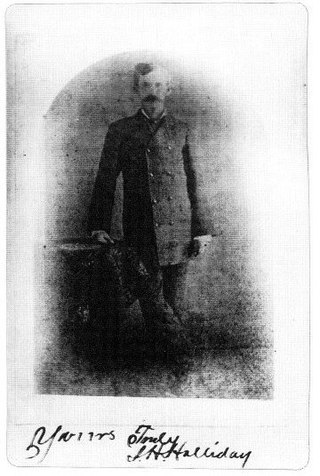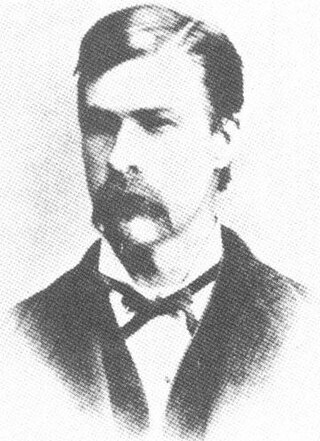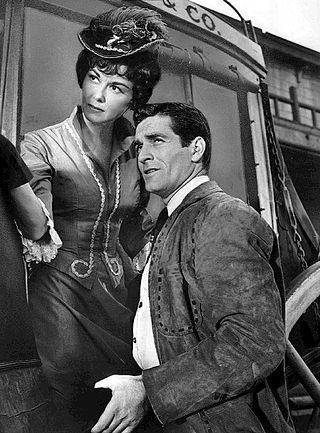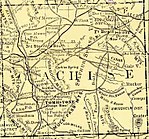Related Research Articles

The gunfight at the O.K. Corral was a thirty-second gunfight between lawmen led by Virgil Earp and members of a loosely organized group of outlaws called the Cowboys that occurred at about 3:00 p.m. on Wednesday, October 26, 1881, in Tombstone, Arizona, United States. It is generally regarded as the most famous gunfight in the history of the American Old West.

John HenryHolliday, better known as Doc Holliday, was an American gambler, gunfighter, and dentist. A close friend and associate of lawman Wyatt Earp, Holliday is best known for his role in the events leading up to and following the Gunfight at the O.K. Corral in Tombstone, Arizona. He developed a reputation as having killed more than a dozen men in various altercations, but modern researchers have concluded that, contrary to popular myth-making, Holliday killed only one to three men. Holliday's colorful life and character have been depicted in many books and portrayed by well-known actors in numerous movies and television series.

Wyatt Berry Stapp Earp was an American lawman and gambler in the American West, including Dodge City, Deadwood, and Tombstone. Earp was involved in the famous gunfight at the O.K. Corral, during which lawmen killed three outlaw Cochise County Cowboys. While Wyatt is often depicted as the key figure in the shootout, his brother Virgil was both Deputy U.S. Marshal and Tombstone City Marshal that day and had considerably more experience in law enforcement as a sheriff, constable, and marshal than did Wyatt. Virgil made the decision to enforce a city ordinance prohibiting carrying weapons in town and to disarm the Cowboys. Wyatt was only a temporary assistant marshal to his brother.

Virgil Walter Earp was both deputy U.S. Marshal and Tombstone, Arizona, City Marshal when he led his younger brothers Wyatt and Morgan, and Doc Holliday, in a confrontation with outlaw Cowboys at the Gunfight at the O.K. Corral on October 26, 1881. They killed brothers Tom and Frank McLaury and Billy Clanton. All three Earp brothers had been the target of repeated death threats made by the Cowboys who were upset by the Earps' interference in their illegal activities. All four lawmen were charged with murder by Ike Clanton, who had run from the gunfight. During a month-long preliminary hearing, Judge Wells Spicer exonerated the men, concluding they had been performing their duty.

Morgan Seth Earp was an American sheriff and lawman. He served as Tombstone, Arizona's Special Policeman when he helped his brothers Virgil and Wyatt, as well as Doc Holliday, confront the outlaw Cochise County Cowboys in the Gunfight at the O.K. Corral on October 26, 1881. All three Earp brothers had been the target of repeated death threats made by the Cowboys who were upset by the Earps' interference in their illegal activities. The lawmen killed Cowboys Tom and Frank McLaury and Billy Clanton. All four lawmen were charged with murder by Billy's older brother, Ike Clanton, who had run from the gunfight. During a month-long preliminary hearing, Judge Wells Spicer exonerated the men, concluding they had been performing their duty.

Gunfight at the O.K. Corral is a 1957 American Western film starring Burt Lancaster as Wyatt Earp and Kirk Douglas as Doc Holliday, and loosely based on the actual event in 1881. The film was directed by John Sturges from a screenplay written by novelist Leon Uris. It was a remake of the 1939 film Frontier Marshall starring Randolph Scott, which was until 1957 the definitive film of the gunfight story.

Billy Claiborne was an American outlaw cowboy, drover, miner, and gunfighter in the American Old West. He killed James Hickey in a confrontation in a saloon, but it was ruled self-defense. He was present at the beginning of the Gunfight at the O.K. Corral, but was unarmed and ran from the shootout. Only a year later, while drunk, he confronted gunfighter "Buckskin" Frank Leslie and was killed.

Joseph Isaac Clanton was a member of a loose association of outlaws known as The Cowboys who clashed with lawmen Wyatt, Virgil and Morgan Earp as well as Doc Holliday. On October 26, 1881, Clanton was present at the Gunfight at the O.K. Corral in the boomtown of Tombstone, Arizona Territory but was unarmed and ran from the gunfight, in which his 19-year-old brother Billy was killed.

The Life and Legend of Wyatt Earp is the first Western television series written for adults. It premiered four days before Gunsmoke on September 6, 1955. Two weeks later came the Clint Walker western Cheyenne. The series is loosely based on the life of frontier marshal Wyatt Earp. The half-hour, black-and-white program aired for six seasons on ABC from 1955 to 1961, with Hugh O'Brian in the title role.

Wyatt Earp is a 1994 American biographical Western drama film directed and produced by Lawrence Kasdan, and co-written by Kasdan and Dan Gordon. The film covers the lawman of the same name's life, from an Iowa farmboy, to a feared marshal, to the feud in Tombstone, Arizona that led to the O.K. Corral gunfight. Starring Kevin Costner in the title role, it features an ensemble supporting cast that includes Gene Hackman, Mark Harmon, Michael Madsen, Bill Pullman, Dennis Quaid, Isabella Rossellini, Tom Sizemore, JoBeth Williams, Mare Winningham and Jim Caviezel in one of his earliest roles.

The Earp Vendetta Ride was a deadly search by a federal posse led by Deputy U.S. Marshal Wyatt Earp for a loose confederation of outlaw "Cowboys" they believed had ambushed his brothers Virgil and Morgan Earp, maiming the former and killing the latter. The two Earp brothers had been attacked in retaliation for the deaths of three Cowboys in the Gunfight at the O.K. Corral on October 26, 1881. From March 20 to April 15, 1882, the federal posse searched southeast Cochise County, Arizona Territory for the men they believed were responsible for the attacks on Virgil and Morgan. Several suspects had been identified and were charged, but were soon released by the court, owing in some cases to legal technicalities and in others to the strength of alibis provided by Cowboy confederates. Wyatt hoped that the legal system would bring the Cowboys to justice, but after suspects in both ambushes were freed, Wyatt resolved to take matters into his own hands.

James Cooksey Earp was a lesser known older brother of Old West lawman Virgil Earp and lawman/gambler Wyatt Earp. Unlike his brothers, he was a saloon-keeper and was not present at the Gunfight at the O.K. Corral on October 26, 1881.

Frank C. Stilwell was an outlaw Cowboy who killed at least two men in Cochise County during 1877–82. Both killings were considered to have been self-defense. For four months he was a deputy sheriff in Tombstone, Arizona Territory for Cochise County Sheriff Johnny Behan. Stilwell owned interests in several mines and various businesses, including a saloon, a wholesale liquor business, a stage line, and at his death livery stables in Charleston and Bisbee. He was also a partner in a Bisbee-area saloon with ex-Texas Ranger Pete Spence.

Nicholas Porter Earp was the father of well-known Western lawmen Virgil, Wyatt, and Morgan, and their lesser-known brothers James, Newton and Warren Earp. He was a justice of the peace, a farmer, cooper, constable, bootlegger, wagon-master, and teacher.

Wyatt Earp: Frontier Marshal (1931) was a best-selling but largely fictional biography of Wyatt Earp written by Stuart N. Lake and published by Houghton Mifflin Company. It was the first biography of Earp, supposedly written with his contributions. It established the Gunfight at the O.K. Corral in the public consciousness and conveyed a mythic story about Wyatt Earp as a fearless lawman in the American Old West. Earp and his wife Josephine Earp tried to control the account, threatening legal action to persuade Lake to exclude Earp's second wife from the book. When the book was published, neither woman was mentioned.

Tom McLaury was an American outlaw. He and his brother Frank owned a ranch outside Tombstone, Arizona, Arizona Territory during the 1880s. He was a member of a group of outlaws Cowboys and cattle rustlers that had ongoing conflicts with lawmen Wyatt, Virgil, and Morgan Earp. The McLaury brothers repeatedly threatened the Earps because they interfered with the Cowboys' illegal activities. On October 26, 1881, Tom and Frank were both killed in the Gunfight at the O.K. Corral in Tombstone, Arizona Territory. The Tombstone shootout was his only gunfight.

The Cochise County Cowboys is the modern name for a loosely associated group of outlaws living in Pima and Cochise County, Arizona in the late 19th century. The term "cowboy", as opposed to "cowhand," had only begun to come into wider usage during the 1870s. In that place and time, "cowboy" was synonymous with "cattle rustler". Such thieves frequently rode across the border into Mexico and stole cattle from Mexican ranches that they then drove back across the border to sell in the United States. Some modern writers consider them to be an early form of organized crime in America.

Cochise County in southeastern Arizona was the scene of a number of violent conflicts in the 19th-century and early 20th-century American Old West, including between white settlers and Apache Indians, between opposing political and economic factions, and between outlaw gangs and local law enforcement. Cochise County was carved off in 1881 from the easternmost portion of Pima County during a formative period in the American Southwest. The era was characterized by rapidly growing boomtowns, the emergence of large-scale farming and ranching interests, lucrative mining operations, and the development of new technologies in railroading and telecommunications. Complicating the situation was staunch resistance to white settlement from local Native American groups, most notably during the Apache Wars, as well as Cochise County's location on the border with Mexico, which not only threatened international conflict but also presented opportunities for criminal smugglers and cattle rustlers.

The Ten-Percent Ring was a title given by the newspaper editors of The Tombstone Epitaph in 1881 to Johnny Behan and his friends for stealing about ten percent of the local Tombstone, Arizona, taxes in the 1880s. Milt Joyce (1847–1889), owner of the Oriental Saloon and chairman of Cochise County, Arizona, supervisors, was also seen as a leader of the Ten Percent Ring. The Tombstone Epitaph was started by John Clum in 1880. The newspaper outlined the corruption charges of Johnny Behan the Cochise County sheriff. When Johnny Behan was the Cochise County sheriff one of his duties was collecting prostitution, gambling, liquor, and theater taxes. As part of his pay, he received 10% of all proceeds collected. There was much talk in the town about the graft political corruption of the sheriff. For this many saw Behan as the head of the Ten Percent Ring and a friend of the outlaw Cochise County Cowboys. Others accused of membership in the ring was Artemus Fay (?–1906), owner of the Tombstone's first newspaper, the Tombstone Weekly Nugget and Harry Wood (1848–1896) a writer for the Weekly Nugget and an under-sheriff of Behan. Along with stealing tax funds, the Ten Percent Ring helped in election fraud and helping the outlaw Cochise County Cowboys. Behan so focused on taxes, that he was very soft on crime. Soon after Behan became sheriff, Virgil Earp was appointed Tombstone city marshal and had his brothers Wyatt Earp and Morgan Earp become special deputy policemen. Behan and the Earps were at conflict as Behan supported the outlaw Clanton and McLaury families. After the Gunfight at the O.K. Corral and the murder of Morgan Earp, Behan did nothing to find the killers of Morgan Earp. Rather than look for Morgan's killers, Behan put out warrants for U.S. marshal Virgil Earp and Wyatt for killing outlaws. On January 31, 1882, Behan was arrested for collecting bills totaling $300 twice, arraigned in front of Justice Stilwell, and discharged due to a technicality. Behan failed to win re-election as sheriff in November of 1882; he would not serve as a peace officer again. Later, he was appointed as the warden of the Yuma Territorial Prison and had various other government jobs until his death in 1912. Milt Joyce departed Tombstone in 1883. On October 10, 1880, Joyce and Doc Holliday had a shoot-out at the Oriental. Joyce died in 1889 at the age of 42 in San Francisco, where he was the owner of the Baldwin Billiard Parlor in 1883 and later the Cafe Royal in San Francisco. Harry M. Woods, a Pennsylvania Infantry Union Veteran, moved to from Tombstone to Nogales, Arizona, where he was a tax collector until his death in 1896. After Artemus Fay departed the Weekly Nugget, which burned in the great fire of 1882 and did not re-open, he worked at the Nugget Mine in Dos Cabezas and start a short-lived paper there, the GoNote. After the death of his wife, Fay moved to Flagstaff and started a newspaper there.
References
- 1 2 3 Thrapp, Dan L. (1991). Encyclopedia of Frontier Biography (Bison Book print ed.). Lincoln: University of Nebraska Press. p. 1313. ISBN 978-0-8032-9420-2 . Retrieved 25 March 2015.
- ↑ Paula Mitchell Marks (1989). And Die in the West: the Story of the O.K. Corral Gunfight. New York: Morrow. p. 114. ISBN 0-671-70614-4.[ permanent dead link ]
- ↑ Roberts, Gary L. (2007). Doc Holliday: The Life and Legend. New York, NY: Wiley, J. p. 243. ISBN 978-0-470-12822-0.
- ↑ Erwin, Richard E. (1993). The Truth about Wyatt Earp (2nd ed.). Carpinteria, CA: O.K. Press. ISBN 9780963393029.
- ↑ "Losing Gambler". Archived from the original on April 12, 2005. Retrieved May 22, 2011.
- 1 2 Guinn, Jeff (17 May 2011). The Last Gunfight: The Real Story of the Shootout at the O.K. Corral and How it Changed the American West (First hardcover ed.). New York: Simon & Schuster. p. 168. ISBN 978-1-4391-5424-3.
- ↑ "Virgil Earp - Upholding the Law of the West" . Retrieved 24 March 2015.
- ↑ "Wyatt Earp". Legends of America. Archived from the original on 16 March 2015. Retrieved 24 March 2015.
